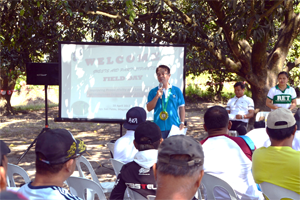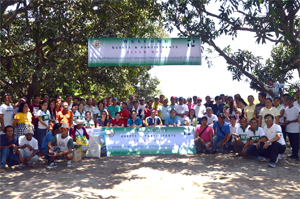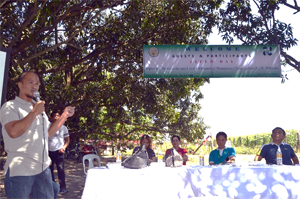 A Farmers’ Field Day showcasing various developed technologies for mungbean was held recently in Barangay San Pablo, Magalang, Pampanga. Among the technologies featured were the Vermitea, Kakawate extracts, Oriental Herbal Nutrient (OHN), Nuclear Polyhedrosis Virus (NPV), Boron fertilization, and Carrageenan plant food supplement for control of major insect pests and diseases in mungbean to increase crop yield.
A Farmers’ Field Day showcasing various developed technologies for mungbean was held recently in Barangay San Pablo, Magalang, Pampanga. Among the technologies featured were the Vermitea, Kakawate extracts, Oriental Herbal Nutrient (OHN), Nuclear Polyhedrosis Virus (NPV), Boron fertilization, and Carrageenan plant food supplement for control of major insect pests and diseases in mungbean to increase crop yield.
These technologies were fruits of the field researches on Integrated Cultural Management System under the Mungbean R&D Program, “Improving Productivity and Local Utilization of Mungbean” funded by the Philippine Council for Agriculture, Aquatic and Natural Resources Research and Development of the Department of Science and Technology (DOST-PCAARRD).
The program is being implemented by a team of researchers from the University of the Philippines Los Baños (UPLB), Pampanga State Agricultural University (PSAU), and the Department of Agriculture - Central Luzon Integrated Agricultural Research Center (DA-CLIARC).
Farmers from Magalang, Mexico, Mabalacat, Arayat, Angeles City, and Macabebe in Pampanga, together with the local government units (LGUs) and members of the Ayala San Agustin Farmers’ Association attended the Farmers’ Field Day.
 Rolando S. Corpuz, DOST-PCAARRD Industry Strategic S&T Program (ISP) Manager for Legumes, presented the industry status, particularly the country’s heavy importation of mungbean caused by low crop yield, lack of farmers’ access to quality and improved seeds, occurrence of pests and diseases, and lack of integrated crop management system to optimize crop yield productivity.
Rolando S. Corpuz, DOST-PCAARRD Industry Strategic S&T Program (ISP) Manager for Legumes, presented the industry status, particularly the country’s heavy importation of mungbean caused by low crop yield, lack of farmers’ access to quality and improved seeds, occurrence of pests and diseases, and lack of integrated crop management system to optimize crop yield productivity.
To address these industry gaps, Corpuz reiterated the importance of S&T interventions such as the development and adoption of improved integrated crop management approaches and value-adding activities for increased crop yield and farm income.
Adoption of the recommended technologies for mungbean production was the persistent message during the Field Day. Besides being an alternative income source for farmers, mungbean also ameliorates the soil and serves as an organic fertilizer.
Angelito Cruz, a farmer-cooperator from Brgy. San Pablo, Magalang, Pampanga, shared his testimony to his fellow farmers on how the S&T interventions and new technologies helped him. Cruz shared that after applying the technologies in his 1.2-hectare farm, he attained a yield of 2.42 tons/ha compared with the 1.75 tons/ha yield without the interventions. The 0.67 ton/ha yield increase translates to an additional income of P38,090.00.
 The adopted technologies in Cruz’s farm include the following: spraying of Nuclear Polyhedrosis Virus (NPV), which was found to be an effective Biological Control Agent (BCA) against pod borers; using Boron fertilization that can double the yield of mungbean (from 0.67 – 0.70 to 1.2-1.4 tons/ha); and using Carrageenan as Plant Food Supplement that can increase crop yield by threefolds (from 0.67 ton to 1.75 tons/ha). Cruz urged his fellow farmers to adopt these technologies and practices for added benefits.
The adopted technologies in Cruz’s farm include the following: spraying of Nuclear Polyhedrosis Virus (NPV), which was found to be an effective Biological Control Agent (BCA) against pod borers; using Boron fertilization that can double the yield of mungbean (from 0.67 – 0.70 to 1.2-1.4 tons/ha); and using Carrageenan as Plant Food Supplement that can increase crop yield by threefolds (from 0.67 ton to 1.75 tons/ha). Cruz urged his fellow farmers to adopt these technologies and practices for added benefits.
Also present during the activity were Dr. Honorio M. Soriano, Jr., PSAU President; Prof. Albert B. Leung, PSAU Assistant Director for R&D; Elmer Mercado, Executive Assistant to the Municipal Mayor of Magalang; Dr. Mary Grace B. Gatan, PSAU Cluster Director for R&D; and Dr. Rodel G. Maghirang, Program Leader from UPLB.
A sensory evaluation of different improved mungbean varieties was also done to determine consumers’ acceptance and preference in terms of appearance, color, taste, and aroma. Towards the end of the event, improved seed varieties were distributed to the farmers for their initial seed stocks and for seed increase.
